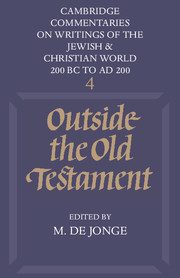Book contents
- Frontmatter
- Contents
- General Editors' Preface
- Editor's Foreword
- Acknowledgements
- Abbreviations
- General Introduction
- Pseudo-Philo, Liber Antiquitatum Biblicarum
- The Ethiopic Book of Enoch
- The Testament of Abraham
- The Testaments of the Twelve Patriarchs
- Joseph and Aseneth
- The Book of Jubilees
- The Testament (Assumption) of Moses
- The Psalms of Solomon
- The Martyrdom of Isaiah
- The Syriac Apocalypse of Baruch
- Paraleipomena Jeremiou
- The Testament of Job
- Index
The Testaments of the Twelve Patriarchs
Published online by Cambridge University Press: 05 June 2012
- Frontmatter
- Contents
- General Editors' Preface
- Editor's Foreword
- Acknowledgements
- Abbreviations
- General Introduction
- Pseudo-Philo, Liber Antiquitatum Biblicarum
- The Ethiopic Book of Enoch
- The Testament of Abraham
- The Testaments of the Twelve Patriarchs
- Joseph and Aseneth
- The Book of Jubilees
- The Testament (Assumption) of Moses
- The Psalms of Solomon
- The Martyrdom of Isaiah
- The Syriac Apocalypse of Baruch
- Paraleipomena Jeremiou
- The Testament of Job
- Index
Summary
Structure and genre
The Testaments of the Twelve Patriarchs (T12P), a pseudepigraphon originally written in Greek, consists of twelve parts or ‘testaments’. Each Testament contains the last words of one of the twelve sons of Jacob addressed to his sons (and other relatives) at the end of his life. It has a stereotyped structure. The ‘farewell speech’ which forms the bulk of a Testament is always preceded by an introductory passage indicating that what is to follow is the Patriarch's farewell discourse and giving some details about the circumstances under which the speech was delivered. All Testaments end with a small passage giving some information about the Patriarch's death and burial. The framework and above all the stereotyped introductory and concluding passages have been grafted upon Old Testament examples, particularly upon Gen. 49 (Jacob's ‘farewell speech’ to his sons).
The ‘farewell speech’ itself usually consists of three parts. First, the Patriarch tells his sons about his life in the past and describes his own moral behaviour (the biographical part). Above all, his former relation towards Joseph forms a constituent element in the description of his ethical attitude in the past. Some of the Patriarchs, like Simeon, Dan and Gad, plead guilty and point to their sins, which consist of vices like hatred, jealousy, envy, anger and lying. Zebulun, however, stresses his goodness to Joseph. The biographical part serves as a kind of introduction to the second part, the parenetic (that is, hortatory) section.
- Type
- Chapter
- Information
- Outside the Old Testament , pp. 71 - 91Publisher: Cambridge University PressPrint publication year: 1986
- 8
- Cited by



